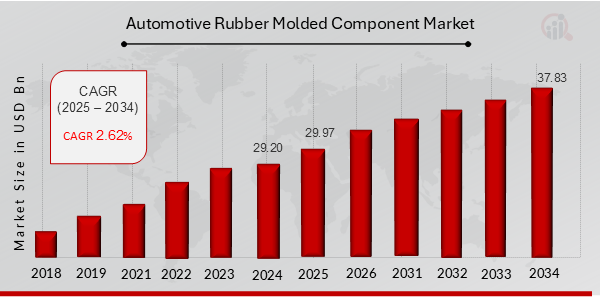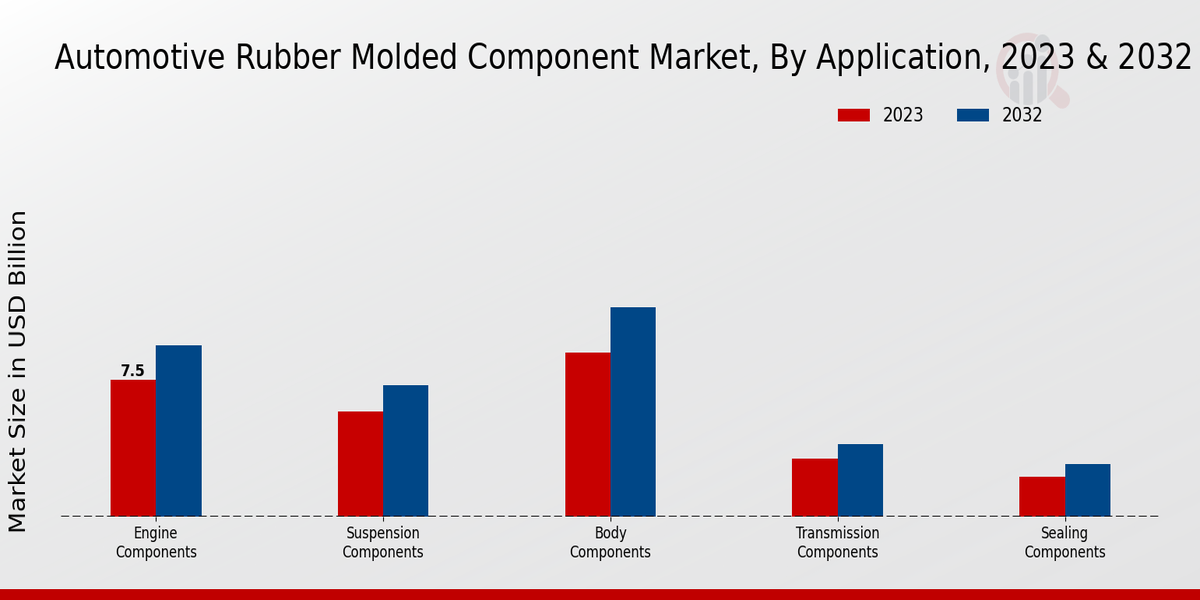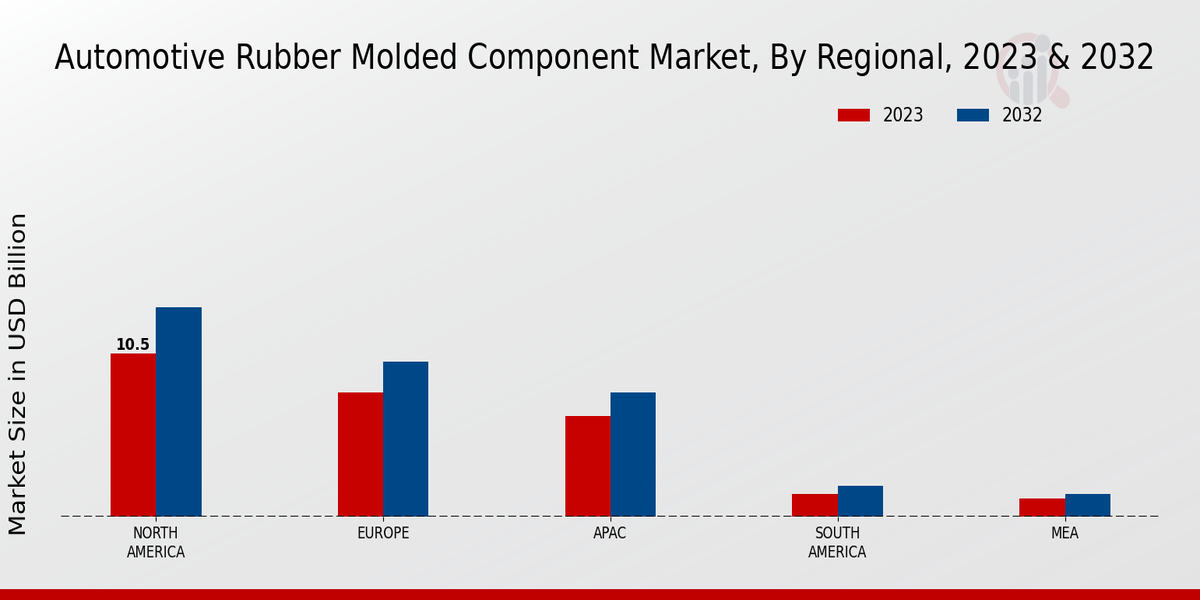Automotive Rubber Molded Component Market Overview
As per MRFR analysis, the Automotive Rubber Molded Component Market Size was estimated at 29.20 (USD Billion) in 2024. The Automotive Rubber Molded Component Market Industry is expected to grow from 29.97 (USD Billion) in 2025 to 37.83 (USD Billion) till 2034, at a CAGR (growth rate) is expected to be around 2.62% during the forecast period (2025 - 2034).
Key Automotive Rubber Molded Component Market Trends Highlighted
The Global Automotive Rubber Molded Component Market is primarily driven by the increasing demand for lightweight and durable materials in vehicle manufacturing. As automotive companies aim to improve fuel efficiency and reduce emissions, there is a growing shift towards using rubber components that can meet stringent performance standards.
Advances in rubber technology and growing consumer preferences for enhanced comfort and safety features in vehicles are also key factors contributing to market growth. Additionally, the rise of electric vehicles is leading to an increased need for specialized rubber components, providing further impetus to the market.
There are numerous opportunities to be explored in the automotive rubber molded component market. The expansion of the electric and hybrid vehicle segment is opening avenues for innovative rubber parts designed for electric powertrains and battery systems.
Furthermore, as consumers become more environmentally conscious, there is a significant opportunity for manufacturers to develop sustainable and eco-friendly rubber components, tapping into a growing market segment.
Collaborations with electric vehicle manufacturers and investments in research and development for next-generation materials can lead to competitive advantages and market expansion.
Recent trends in the industry reveal a focus on automation and the adoption of advanced manufacturing processes. Companies are increasingly integrating smart manufacturing technology and robotics into production lines to enhance efficiency and reduce costs.
Moreover, with the heightened emphasis on safety regulations, the development of rubber components that meet these stringent guidelines is shaping the market landscape. Sustainability is also becoming a prominent trend, with manufacturers looking to incorporate recycled materials and reduce waste in their production processes.
As the automotive sector continues to evolve, these trends will play a vital role in shaping the future of the automotive rubber molded component market

Source: Primary Research, Secondary Research, MRFR Database and Analyst Review
Automotive Rubber Molded Component Market Drivers
Increased Demand for Lightweight Vehicles
The Global Automotive Rubber Molded Component Market is experiencing a significant shift towards lightweight vehicles. The automotive sector is continuously striving to improve fuel efficiency and reduce emissions, resulting in an increased demand for lightweight materials, including rubber molded components.
These components play a crucial role in reducing the overall weight of a vehicle without compromising on performance and safety. As governments worldwide implement stricter emission regulations, the need for lightweight vehicles becomes even more pronounced, thereby driving the demand for rubber-molded parts in the automotive sector.
This trend is expected to remain strong in the upcoming years as manufacturers seek to innovate and develop lighter and more efficient vehicles, which in turn will contribute positively to the growth and expansion of the Global Automotive Rubber Molded Component Market.
Furthermore, advancements in rubber technology and manufacturing processes enhance durability and functionality, making these components more appealing for modern automotive applications.
Factors such as technological innovations aimed at increasing the lifespan of rubber parts will continue to bolster market growth, aligning with the automotive industry's focus on sustainability and eco-friendliness.
Manufacturers are also exploring options to incorporate recycled rubber materials into their products, catering to environmentally conscious consumers and automotive companies alike. As a result, the shift towards lightweight vehicles and sustainable practices is expected to be a primary driver in the Global Automotive Rubber Molded Component Market.
Growth in Electric and Hybrid Vehicle Production
The Global Automotive Rubber Molded Component Market is benefiting from the rise in production and sales of electric and hybrid vehicles. As automobile manufacturers transition to more sustainable forms of transportation, the demand for specialized rubber components tailored for electric and hybrid vehicles is set to increase.
These vehicles often require unique rubber parts for critical applications, such as battery insulation, sealing, and vibration dampening. This shift opens new opportunities for manufacturers specializing in rubber-molded components, thereby driving market growth moving forward.
Technological Advancements in Manufacturing Processes
Technological innovations within the automotive sector are reshaping the Global Automotive Rubber Molded Component Market. With the introduction of advanced manufacturing techniques, such as 3D printing and automation, companies are enhancing their production capabilities and efficiencies.
These advancements allow for better precision, reduced waste, and the ability to produce complex rubber-molded components at a faster rate. Moreover, improved manufacturing processes are facilitating customization and scalability, making it easier for manufacturers to meet diverse consumer demands.
As these technologies continue to evolve and become more widely adopted, they will serve as a significant driver of growth in the Global Automotive Rubber Molded Component Market
Automotive Rubber Molded Component Market Segment Insights:
Automotive Rubber Molded Component Market Application Insights
The Global Automotive Rubber Molded Component Market is characterized by a diverse application landscape that plays a pivotal role in vehicle performance and safety.
Among these, the Engine Components segment held a significant position, valued at 7.5 USD Billion. This dominance is attributed to the critical role that rubber components play in ensuring engine efficiency and durability, making them essential for modern vehicles.
The Body Components segment followed closely, standing at 9.0 USD Billion, emphasizing the importance of molded rubber in enhancing the structural integrity and aesthetic appeal of automotive exteriors.
Suspension Components, valued at 5.8 USD Billion, underscored the necessity of rubber parts for vehicle stability and ride quality, which are key concerns for consumers.
Furthermore, Transmission Components, with a valuation of 3.2 USD Billion, highlighted the significance of rubber during power transfer processes within vehicles, ensuring smoother functioning and longevity of mechanical systems.
Lastly, the Sealing Components segment, valued at 2.22 USD Billion, demonstrated its vital role in maintaining vehicle integrity by preventing leaks and protecting against environmental elements. Overall, the Global Automotive Rubber Molded Component Market segmentation showcases a balanced concentration of applications.
The anticipated steady growth in this market can be attributed to advancements in automotive technology and increasing consumer expectations for performance and safety. Overall, trends such as electric vehicles and lightweight materials are expected to further fuel the growth of the global automotive rubber molded component market, driving demand for high-quality, durable components across all segments.
As the market evolves, opportunities abound for innovation and differentiation among industry players, positioning them to capitalize on emerging trends in vehicle manufacturing and consumer preferences.

Source: Primary Research, Secondary Research, MRFR Database and Analyst Review
Automotive Rubber Molded Component Market Type Insights
The Global Automotive Rubber Molded Component Market displays notable dynamics across various types, including Natural Rubber, Synthetic Rubber, Thermoplastic Elastomer, and Butyl Rubber. Each type plays a critical role, with Natural Rubber widely used for its excellent elasticity and durability, making it essential in tire manufacturing.
Synthetic Rubber has gained significant traction due to its versatility and resistance properties, which are crucial for high-performance automotive applications. Thermoplastic Elastomer is instrumental in the production of lightweight components that improve fuel efficiency while maintaining high-performance standards.
Butyl Rubber is predominantly recognized for its air retention capabilities, playing a vital role in enhancing the longevity and performance of tires.
The variety of types within the automotive rubber molded component industry reflects the ongoing trends toward innovation, with manufacturers increasingly focusing on improving material properties to address environmental regulations and consumer demands for sustainability.
Market growth is bolstered by advancements in material science and increasing automotive production, presenting both challenges and opportunities for industry players.
Automotive Rubber Molded Component Market End Use Insights
The end use of these components can be categorized into several applications, with passenger vehicles, commercial vehicles, and electric vehicles being key focuses. Passenger vehicles represent a significant portion of the market due to their diverse application of rubber components in areas such as sealing, vibration dampening, and interior finishes.
The commercial vehicle segment is also crucial, as it often demands robust and durable components to withstand rigorous operational conditions.
Furthermore, electric vehicles are emerging as a dominant force within the market, driving innovation and increasing the demand for specialized rubber-molded components that enhance performance and sustainability.
The market growth is propelled by rising vehicle production, advancements in technology, and a shift toward electric mobility, creating opportunities while also presenting challenges related to material performance and environmental regulations.
Overall, the Global Automotive Rubber Molded Component Market segmentation reveals a landscape ripe with potential as these segments continue to evolve together.
Automotive Rubber Molded Component Market Production Process Insights
The Global Automotive Rubber Molded Component Market, focusing on the Production Process segment, is a crucial area with significant contributions from various methodologies of manufacturing.
This segment is diversified into various production methodologies, including Compression Molding, Injection Molding, Transfer Molding, and Extrusion, each playing an important role in the production of rubber components.
Compression Molding is known for its efficiency in producing large quantities, while Injection Molding provides precision and versatility for complex designs, thereby being highly favored for specific applications.
Transfer Molding offers an advantage in producing larger rubber components with varying complexities. Extrusion plays an essential role in creating continuous profiles, which are vital for various automotive applications.
The combination of these methodologies not only highlights the importance of adaptability and innovation in the rubber-molded component market but also showcases how efficiently these processes cater to the growing demand and technological advancements in the automotive industry.
The market growth in this segment is driven by an increasing need for lighter and more durable materials in automotive manufacturing, fueled further by trends toward electric vehicles and sustainability initiatives.
Overall, the Global Automotive Rubber Molded Component Market data reflects a robust framework for innovation and efficiency within the Production Process segment.
Automotive Rubber Molded Component Market Regional Insights
The Global Automotive Rubber Molded Component Market revenue reflects a diverse regional landscape, with North America standing out as the largest market, valued at 10.5 USD Billion in 2023 and projected to reach 13.5 USD Billion by 2032. This dominance is attributed to a well-established automotive industry and an increasing demand for advanced rubber-molded components.
Europe followed closely, with a valuation of 8.0 USD Billion in 2023, contributing significantly to the market growth through technological advancements and sustainable practices.
The APAC region, valued at 6.5 USD Billion in 2023, showcased robust expansion driven by a growing automotive sector and rising consumer demand, making it a key player in the Global Automotive Rubber Molded Component Market data.
Meanwhile, South America and MEA represented smaller shares, valued at 1.5 USD Billion and 1.2 USD Billion respectively in 2023, but are poised for growth as automotive manufacturing expands in these markets.
The market segmentation highlights North America's majority holding, reflecting its strategic importance in the industry while emerging regions like APAC present significant opportunities for industry stakeholders.

Source: Primary Research, Secondary Research, MRFR Database and Analyst Review
Automotive Rubber Molded Component Market Key Players and Competitive Insights:
The Global Automotive Rubber Molded Component Market is characterized by a diverse array of companies specializing in the production and supply of rubber components that are integral to the automotive industry.
As the automotive sector evolves, driven by advancements in technology, sustainability requirements, and consumer preferences, the competition within this market becomes increasingly intense. Companies are constantly innovating to improve product performance while reducing costs, all while adhering to stringent regulatory standards.
The market encompasses various segments, including tires, seals, gaskets, and vibration-damping systems, making it crucial for manufacturers to establish a strong competitive edge.
With the growing emphasis on electric and autonomous vehicles, companies in this space are also focusing on creating rubber components that enhance vehicle efficiency and performance, further impacting competitive dynamics.
Yokohama Rubber has established a substantial presence in the Global Automotive Rubber Molded Component Market through its commitment to innovation and quality. With a legacy of developing advanced rubber technologies, the company has become a leading player in the manufacturing of rubber molded components, particularly in the tire segment.
Yokohama Rubber leverages its technological prowess to produce high-performance tires and sealing solutions that cater to a broad range of vehicles, from passenger cars to commercial trucks. The company's focus on research and development has enabled it to introduce materials and designs that enhance durability and reduce rolling resistance, contributing to improved fuel efficiency.
Furthermore, Yokohama Rubber's strong brand reputation and customer trust underscore its competitive advantages, allowing it to maintain a robust foothold in the market.
Carlstar Group has carved out a unique niche within the Global Automotive Rubber Molded Component Market, particularly known for its specialty in the production of tires and wheels for various off-road vehicles.
The company's extensive portfolio includes a wide array of rubber molded components that are tailored to meet the specific demands of both recreational and industrial applications. Carlstar Group's strength lies in its ability to offer diverse product lines that address the needs of different customer segments, including agriculture, construction, and lawn and garden.
By focusing on high-quality manufacturing processes and maintaining rigorous quality control standards, the company has built a reputation for offering reliable and durable products. Additionally, Carlstar Group's commitment to customer service and responsiveness strengthens its competitive position, ensuring strong relationships in the market and the ability to adapt to changing customer needs.
Key Companies in the Automotive Rubber Molded Component Market Include:
- Yokohama Rubber
- Carlstar Group
- Michelin
- Dunlop
- Bridgestone
- Continental
- Goodyear Tire and Rubber Company
- Sumitomo Rubber Industries
- Cooper Tire and Rubber Company
- Trelleborg
- Pirelli
- Johnson Controls
- Firestone
- Gates Corporation
- Hankook Tire
Automotive Rubber Molded Component Market Developments
The Global Automotive Rubber Molded Component Market has seen significant recent developments, with companies like Yokohama Rubber and Michelin making strides in product innovation to enhance vehicle performance and sustainability.
The market is experiencing notable growth, driven by increasing demand for high-performance vehicles and advances in manufacturing technologies adopted by firms like Bridgestone and Goodyear Tire and Rubber Company.
Current affairs underscore a competitive landscape, with tire manufacturers such as Continental and Hankook Tire focusing on eco-friendly materials and processes to align with global sustainability trends.
Recent merger and acquisition activities include the strategic partnerships formed by Carlstar Group and Trelleborg, aiming to bolster their market positions through expanded product offerings and enhanced operational efficiencies.
Additionally, companies like Sumitomo Rubber Industries and Cooper Tire and Rubber Company are capitalizing on emerging markets, indicating a shift in investment focus and a potential increase in market valuation.
Furthermore, the ongoing supply chain challenges due to geopolitical tensions and raw material costs are creating opportunities for companies, including Johnson Controls and Firestone, to innovate and adapt their supply strategies, affirming a dynamic evolving sector within automotive rubber molded components.
Automotive Rubber Molded Component Market Segmentation Insights
Automotive Rubber Molded Component Market Application Outlook
- Engine Components
- Suspension Components
- Body Components
- Transmission Components
- Sealing Components
Automotive Rubber Molded Component Market Type Outlook
- Natural Rubber
- Synthetic Rubber
- Thermoplastic Elastomer
- Butyl Rubber
Automotive Rubber Molded Component Market End Use Outlook
- Passenger Vehicles
- Commercial Vehicles
- Electric Vehicles
Automotive Rubber Molded Component Market Production Process Outlook
- Compression Molding
- Injection Molding
- Transfer Molding
- Extrusion
Automotive Rubber Molded Component Market Regional Outlook
- North America
- Europe
- South America
- Asia Pacific
- Middle East and Africa
| Report Attribute/Metric |
Details |
|
Market Size 2024
|
29.20 (USD Billion)
|
|
Market Size 2025
|
29.97 (USD Billion)
|
|
Market Size 2034
|
37.83 (USD Billion)
|
|
Compound Annual Growth Rate (CAGR)
|
2.62% (2025 - 2034)
|
|
Report Coverage
|
Revenue Forecast, Competitive Landscape, Growth Factors, and Trends
|
|
Base Year
|
2024
|
|
Market Forecast Period
|
2025 - 2034
|
|
Historical Data
|
2019 - 2023
|
| Market Forecast Units |
USD Billion |
| Key Companies Profiled |
Yokohama Rubber, Carlstar Group, Michelin, Dunlop, Bridgestone, Continental, Goodyear Tire and Rubber Company, Sumitomo Rubber Industries, Cooper Tire and Rubber Company, Trelleborg, Pirelli, Johnson Controls, Firestone, Gates Corporation, Hankook Tire |
| Segments Covered |
Application, Type, End Use, Production Process, Regional |
| Key Market Opportunities |
Electric vehicle demand surge, Increasing vehicle production rate, Advanced materials for sustainability, Growing automotive aftermarket sector, Expansion in emerging markets |
| Key Market Dynamics |
Increased vehicle production, Demand for lightweight materials, Stringent emission regulations, Growth in electric vehicles, Rising aftermarket sales |
| Countries Covered |
North America, Europe, APAC, South America, MEA |
Frequently Asked Questions (FAQ) :
The Global Automotive Rubber Molded Component Market is expected to be valued at 37.83 USD Billion in 2034.
The projected CAGR for the Global Automotive Rubber Molded Component Market from 2025 to 2034 is 2.62%.
North America is expected to hold the largest market share, valued at 13.5 USD Billion in 2032.
The market size for Engine Components is projected to reach 9.4 USD Billion by 2032.
The market for Suspension Components is expected to grow to 7.2 USD Billion by 2032.
The market value for Body Components in 2023 stood at 9.0 USD Billion.
Yokohama Rubber is one of the significant players in the Global Automotive Rubber Molded Component Market.
The expected market value for Sealing Components is projected to be 2.9 USD Billion by 2032.
The market size for the APAC region is expected to be 8.0 USD Billion in 2032.
The Body Components segment is anticipated to grow, reaching 11.5 USD Billion by 2032.

















